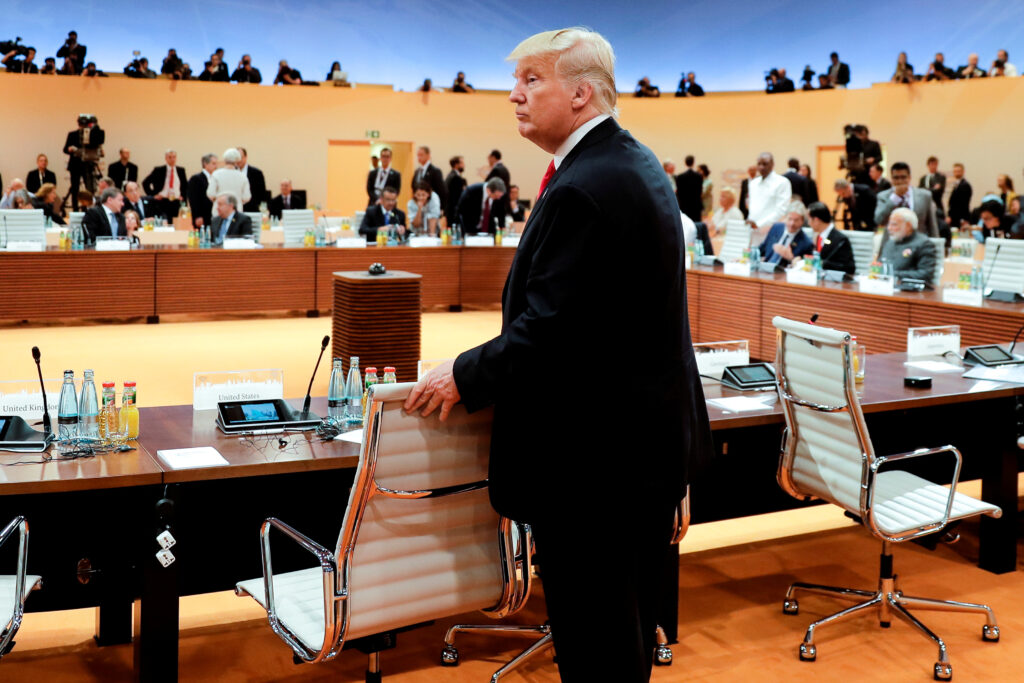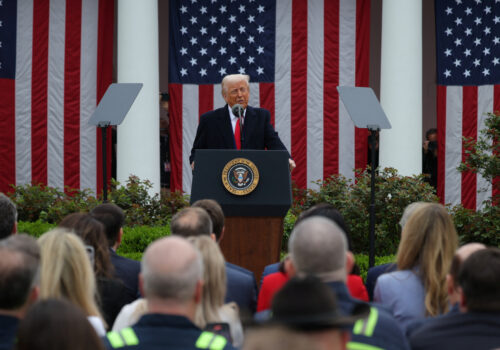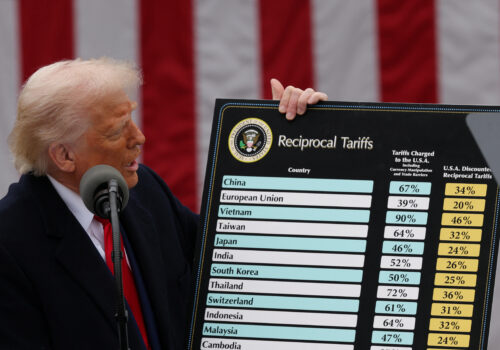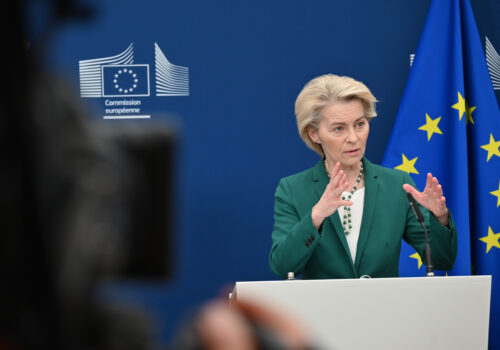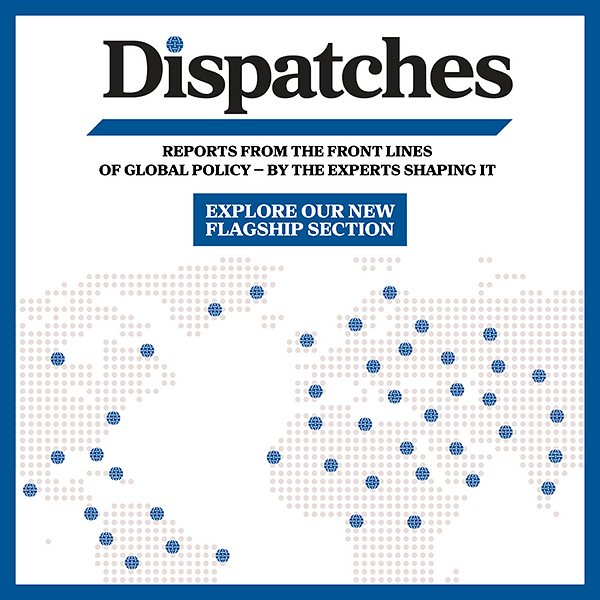US President Donald Trump has launched a global economic war without any allies. That’s why—unlike previous economic crises in this century—there is no one coming to save the global economy if the situation starts to unravel.
There is a model to deal with economic and financial crises over the past two decades, and it requires activating the Group of Twenty (G20) and relying on the US Federal Reserve to provide liquidity to a financial system under stress. Neither option will be available in the current challenge.
First, the G20. The G20 was created by the United States and Canada in the late 1990s to bring rising economic powers such as China into the decision-making process and prevent another wave of debt crises like the Mexican peso crisis of 1994 and the Asian financial crisis of 1997. In 2008, as Lehman Brothers collapsed and financial markets around the world began to panic, then President George W. Bush called for an emergency summit of G20 leaders—the first time the heads of state and government from the world’s largest economies had convened.
What followed was one of the great successes of international economic coordination in the twenty-first century—the so-called London Moment, when the G20 agreed to inject five trillion dollars to stabilize the global economy. With this joint coordination, the leaders sent a powerful signal to the rest of the world that they would not let a recession turn into a worldwide depression.
Nearly twelve years later, at the outbreak of the COVID-19 pandemic, the same group of leaders convened to work on debt relief, fiscal stimulus, and—critically—access to vaccines.
Now we face the third major economic shock of the twenty-first century. But this one is fully man-made by one specific policy decision. It could, of course, be undone by a reversal of that decision, which if it kicks in at midnight tonight will send US tariff rates from 2.5 percent last year to over 20 percent this year—the highest in a hundred years. But as I have said since November, Donald Trump is serious about tariffs, they are not only a negotiating tool, and that means many of them are likely here to stay.
There will be no “London Moment” this time around. The United States can’t call for a coordinated response to a trade war it initiated—one that is predicated on the idea that the rest of the world is taking advantage of the United States. Some countries actually have an incentive to see the situation in financial markets worsen, in the hope that it puts pressure on the Trump administration to relent. Others may want to make bilateral deals, but a coordinated effort between China, Europe, Russia, and Brazil is off the table. This will make for an especially tense G20 finance ministers meeting in ten days, when Treasury Secretary Scott Bessent meets his colleagues for the first time at the International Monetary Fund-World Bank Spring Meetings in Washington, DC. Bessent can expect to face pointed questions from his counterparts on why the United States is reverting to the very protectionism that led to the creation of the Bretton Woods system eighty years ago.
The United States can’t call for a coordinated response to a trade war it initiated.
The second—and more powerful—actor in the global economy has been the US Federal Reserve. In the global financial crisis and during the COVID-19 pandemic, the Federal Reserve slashed rates to zero, injected trillions into the US economy through quantitative easing, and issued swap lines around the world to help countries access dollars when they most needed it.
This time around, Chair Jerome Powell has signaled to the White House the so-called “Powell Put” is a long way off. On Friday, Trump posted on social media, “This would be a PERFECT time for Fed Chairman Jerome Powell to cut Interest Rates.” This makes sense if you believe tariffs will indeed cause higher prices and put economic stress on millions of US citizens. But Powell said the same day that “we don’t need to be in a hurry.” He wants to see how the crisis unfolds. In a different situation, if the markets had fallen by 20 percent because of, say, a virus or a terrorist attack on the United States, then the Fed would likely have reacted very differently.
Powell, however, understands that a trade war built on high US tariffs could prove to be stagflationary—the dreaded combination of higher prices with slower growth. A stagflationary environment isn’t necessarily the time for pre-emptive rate cuts since lower rates might further fuel inflation. Powell also wants to send the signal that this policy could be undone by the White House—or, of course, by Congress—and show his colleagues in Washington that they can’t rely on the Fed to fix a problem of their own making.
The situation is going to become incredibly complicated for the Fed in the weeks ahead. Economic conditions in the United States could deteriorate quickly. Other central banks, including the European Central Bank, the Bank of England, and the Bank of Canada, may start cutting rates. That’s because they are primarily worried about weaker economic growth, not inflation from higher import costs.
This will leave the US Federal Reserve with higher rates than the rest of the world—and Trump will likely grow increasingly frustrated with a Fed chair whom he has clashed with over and over again since he appointed Powell back in 2017. Trump is likely to feel that the Fed is undercutting him in his trade war while other central banks are supporting their political leadership. The truth will be more nuanced.
Don’t expect the pressure to get to Powell.
Powell has exactly one year left on his term, and he appears committed to leave a legacy as a Federal Reserve chair who fiercely protected the institution’s dual mandate and independence. So, while there may be an economic pain point where the Fed has to step in—it’s further away than both Trump and the markets are hoping.
In the past week analysts have been trying, understandably, to compare the market reaction to what happened during the global financial crisis and the COVID-19 pandemic. But the reality is that these are both poor barometers for the situation. In both previous economic crises this century, the toolkit of international coordination and central-bank firepower were deployed to stabilize the situation. This time, the same tools won’t fix what’s being broken.
Josh Lipsky is the senior director of the Atlantic Council’s GeoEconomics Center and a former adviser at the International Monetary Fund.
Further reading
Fri, Apr 4, 2025
Experts react: How the world is responding to Trump’s ‘liberation day’ tariffs
New Atlanticist By
Atlantic Council experts tour the world to take stock of how US trading partners are responding to US President Donald Trump’s new reciprocal tariffs.
Wed, Apr 2, 2025
How Trump’s ‘liberation day’ tariffs will transform global trade
Fast Thinking By
Our experts share their insights on how US President Donald Trump’s sweeping tariffs will impact US trade partnerships and the global economy.
Tue, Apr 8, 2025
The EU could respond to Trump’s tariffs with a new ‘anti-coercion instrument.’ Here’s what to know.
New Atlanticist By
Confronted with the latest round of US tariffs, the European Union is considering a new but untested tool in its economic-security toolbox.
Image: U.S. President Donald Trump arrives for a working session at the G-20 summit in Hamburg, northern Germany, Saturday, July 8, 2017. REUTERS/Markus Schreiber.
